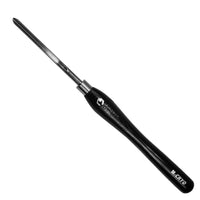Roughing Gouge vs. Bowl Gouge: Unpacking Their Unique Roles in Woodturning

Woodturing is a fascinating craft that blends artistry with precision, relying on a variety of specialized tools to achieve stunning results. Among the essential tools in a woodturner's kit are the roughing gouge and the bowl gouge. While both play pivotal roles in shaping wood, they are designed for different tasks and have unique characteristics that set them apart. Understanding the differences between these two gouges is crucial for any woodturner looking to enhance their skills and achieve optimal results in their projects.
The roughing gouge is primarily used for transforming rough, square or rectangular blanks into cylindrical shapes. Its design features a broad, flat blade with a deep flute, which allows it to remove material quickly and efficiently. This tool is particularly effective in the initial stages of woodturning when the goal is to eliminate excess wood and create a more manageable workpiece. With its ability to tackle large amounts of material rapidly, the roughing gouge is indispensable for shaping spindles, legs, and other cylindrical forms.
One of the key attributes of the roughing gouge is its cutting angle. The bevel angle is generally shallow, typically around 20 to 30 degrees, which allows for easy penetration into the wood fibers. This design enables the turner to apply pressure and make aggressive cuts, facilitating the rapid removal of material. However, while the roughing gouge excels at removing bulk material, it is not ideal for detailed or delicate work. Its flat blade can leave a rough surface, necessitating further refinement with other tools.
In contrast, the bowl gouge is specifically designed for the intricate task of hollowing and shaping bowls and other curved forms. The bowl gouge features a more rounded profile, with a deeper flute that allows it to create smooth, flowing curves inside bowls. This tool is essential for achieving the elegant contours and polished finishes that characterize well-crafted wooden bowls. The bowl gouge allows for precise control, enabling the woodturner to navigate the complexities of concave surfaces with ease.
The bevel angle of a bowl gouge is typically steeper than that of a roughing gouge, often ranging from 40 to 60 degrees. This design is critical for the controlled cutting needed when hollowing out a bowl. The steeper bevel allows for smoother cuts and better handling of the tool as it sweeps across the interior surfaces. Unlike the roughing gouge, which is primarily used for bulk removal, the bowl gouge is suited for finesse and detail work.
The techniques employed with these two tools also differ significantly. When using a roughing gouge, the turner often engages in a pushing motion, relying on the tool's flat blade to remove wood quickly. This technique can be effective for achieving a rough shape but may lack the control needed for intricate cuts. Conversely, bowl gouges are typically used with pull cuts or sweep cuts, allowing the turner to create smooth arcs and flowing shapes. This technique takes full advantage of the bowl gouge's design, ensuring that the cuts are clean and precise.
Another important distinction between the roughing gouge and the bowl gouge lies in their intended applications. The roughing gouge is most effective during the early stages of turning when the objective is to quickly round out a workpiece. It is an ideal tool for roughing out spindles or creating basic cylindrical forms before moving on to more detailed work. In contrast, the bowl gouge is essential for the hollowing phase of bowl turning. It is designed to handle the intricate cuts necessary for creating the interior shapes and curves that make bowls visually appealing and functional.
Using a roughing gouge in place of a bowl gouge can lead to challenges and frustrations. While it may be possible to perform some initial shaping with a roughing gouge on a bowl blank, it lacks the finesse required for achieving the smooth, flowing surfaces characteristic of a well-turned bowl. Attempting to hollow out a bowl using a roughing gouge may result in uneven surfaces and increased risk of catching or tearing the wood fibers, leading to potential errors that could compromise the overall quality of the finished piece.
In summary, while the roughing gouge and bowl gouge may appear similar at first glance, they are fundamentally different tools designed for distinct tasks within the woodturning process. The roughing gouge excels at rapidly removing material and shaping basic forms, while the bowl gouge is specialized for the intricate work required in hollowing and detailing bowls. Understanding the unique characteristics and applications of each tool allows woodturners to select the right gouge for the job, leading to improved results and a more enjoyable turning experience. By recognizing the importance of using the appropriate tool, woodturners can enhance their skills, produce higher-quality pieces, and fully embrace the creative journey that is woodturning.
|